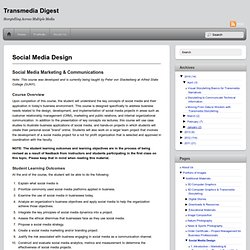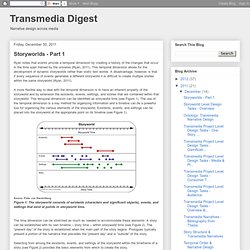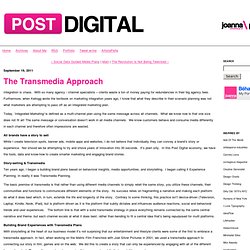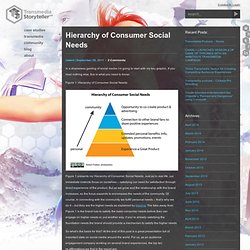

Christy Dena Presentations. Transmedia marketing: storytelling for business, art and education. Transmedia documentation examples. Storytelling Tools. Story Structures for Transmedia Narratives - Part 2. - Transmedia Digest. Social Media Marketing & Communications Note: This course was developed and is currently being taught by Peter von Stackelberg at Alfred State College (SUNY).

Course Overview Upon completion of this course, the student will understand the key concepts of social media and their application in today’s business environment. This course is designed specifically to address business needs related to the design, development, and implementation of social media projects in areas such as customer relationship management (CRM), marketing and public relations, and internal organizational communication. In addition to the presentation of key concepts via lectures, this course will use case studies to illustrate business applications of social media, and hands-on projects in which students will create their personal social “brand” online.
Student Learning Outcomes At the end of the course, the student will be able to do the following: Learning Objectives. December 2011. Rather than trying to include a bibliography of citations in the individual posts on this blog, I've decided to list the entire bibliography here.

In addition to referencing individual aspects of the blog posts, this bibliography can provide a useful guide to literature relevant to transmedia narratives. Aarseth, E. (2004). Quest Games as Post-Narrative Discourse. In M. -L. Abbott, H. Aboriginal Peoples Television Network. (2011). Ahmad, A., & Thompson, J. (2009). Alexander, B. (2011). ALL Star Wars Crawls Episodes I-VI . (2008). Ames, M., & Naaman, M. (2007). Angleman, S. Askehave, I., & Nielsen, A.
Bantz, C. Barthes, R. (1974). Barton, K. Bell, M. Bickham, J. World's Best Way to Make & Share Comics - (Private Browsing) Collaborative Development & Testing Stories On the Fly. iDoc Storytelling Using False Personas. Transmedia vs Repurposing. When considering a transmedia extension for musicians, it is important to understand the difference between extension and repurposing.
Of all the artistic expressions, music is the easiest to toss onto another platform without much thought or intent, often as the background score to unrelated content. While this may garner hefty profits, it does nothing to expand on the music itself. Transmedia allows for musicians to take their music and bring it to life in new forms. They can do this by capitalizing on the benefits of individual platforms, such as the long-form storytelling of television or the immersive quality of video games, that are not available on traditional audio formats. The music itself does not even need to be featured; clothing lines by artists such as Gwen Stefani and M.I.A. reflect the aesthetic and tone of their work without directly referencing specific songs. So how do these two approaches look different? Here are some comparisons: Repurposing: Queen’s We Will Rock You.
The Transmedia Approach. Integration is chaos.

With so many agency / channel specialists – clients waste a ton of money paying for redundancies in their big agency fees. Furthermore, when Kellogg wrote the textbook on marketing integration years ago, I know that what they describe in their scenario planning was not what marketers are attempting to pass off as an integrated marketing plan. Today, 'Integrated Marketing' is defined as a multi-channel plan using the same message across all channels.
What we know now is that one size does not fit all! The same message or conversation doesn’t work in all media channels. All brands have a story to sell While I create television spots, banner ads, mobile apps and websites, I do not believe that individually they can convey a brand’s story or experience. Steve Peters » Blog Archive » How to Design an ARG in 20 Easy Steps. So, since I continue to be an open-source kinda guy where Alternate Reality Games are concerned, here are (apparently) the simple steps to building an ARG, to save everyone the trouble of re-inventing the wheel every time: Take all of the above, bundle it up in a Light Narrative Wrapper™, and voila!

You’re now an ARG Designer! Congratulations! Note: This list can also be used as an ARG Drinking Game. Hierarchy of Consumer Social Needs. In a shameless gaming of social media I’m going to start with my key graphic.

If you read nothing else, this is what you need to know: Figure 1: Hierarchy of Consumer Social Needs Figure 1 presents my Hierarchy of Consumer Social Needs. Just as in real life, our immediate instincts focus on ourselves – satisfying our need for satisfaction through direct experience of the product. But as we grow and the relationship with the brand increases, so the focus expands to encompass the needs of the community. So what’s the basis for this? Offline brand experiences are the main online conversation starterspeople are more like (61%) to share positive experiences than negative (46%)when going online most people want to connect with others who have had positive experiencesmore than 50% of people are connected to brands (more likely to be women under 34).